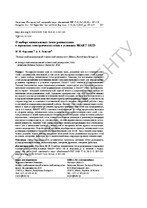| dc.contributor.author | Фурсанов, М. И. | ru |
| dc.contributor.author | Золотой, А. А. | ru |
| dc.coverage.spatial | Минск | ru |
| dc.date.accessioned | 2018-05-29T05:28:07Z | |
| dc.date.available | 2018-05-29T05:28:07Z | |
| dc.date.issued | 2018 | |
| dc.identifier.citation | Фурсанов, М. И. О выборе оптимальных точек размыкания в городских электрических сетях в условиях SMART GRID = On the Choice of the Optimal Points of Opening in City Power Grids in the Conditions of the SMART GRID / М. И. Фурсанов, А. А. Золотой // Энергетика. Известия высших учебных заведений и энергетических объединений СНГ. - 2018. - № 3. - С. 207-219. | ru |
| dc.identifier.uri | https://rep.bntu.by/handle/data/41606 | |
| dc.description.abstract | Усовершенствована одна из основных задач, решаемых для всех электрических сетей с разомкнутой топологией, в том числе для городских электрических сетей, а именно – задача выбора оптимальных точек размыкания. Показано, что насыщение городских сетей распределенными источниками малой генерации приводит к тому, что определяемые режимные параметры в условиях городских SMART GRID становятся наблюдаемыми. Поэтому большинство задач управления режимами, характерных для городских распределительных электрических сетей традиционного исполнения, в SMART GRID свою актуальность теряют. Основной технологической задачей является совершенствование выбора оптимальных точек размыкания сетей. Городские электрические сети ОЭС Беларуси активно насыщаются распределенными источниками малой генерации, которые могут подключаться к высоковольтным шинам потребительских трансформаторных подстанций, в том числе на стороне нагрузки, и оснащаются автоматикой для обеспечения синхронной работы с энергосистемой и поддержания автономной работы. Поэтому учет таких генерирующих источников в задачах управления режимами городских электрических сетей как традиционных, так и в условиях SMART GRID становится необходимым. В статье предложены методика и алгоритм выбора оптимальных точек размыкания городских электрических сетей с учетом различных условий применения источников малой генерации: когда источник работает параллельно с электрической сетью и имеет постоянные активную и реактивную генерации или питает изолированную от сети нагрузку с учетом ограничения на генерируемую источником мощность. Решение этой задачи позволяет снизить потери мощности и электроэнергии в сети в значительно большей степени, чем от внедрения любого другого эксплуатационного мероприятия. Разработанный алгоритм апробирован на примере оптимизации точек размыкания фрагмента городской распределительной сети 10 кВ. Также предложено эффективное решение задачи выбора начальных положений точек размыкания городских сетей на основе алгоритма Дейкстры, что в значительной мере сокращает время их оптимизации. | ru |
| dc.language.iso | ru | ru |
| dc.publisher | БНТУ | ru |
| dc.title | О выборе оптимальных точек размыкания в городских электрических сетях в условиях SMART GRID | ru |
| dc.title.alternative | On the Choice of the Optimal Points of Opening in City Power Grids in the Conditions of the SMART GRID | en |
| dc.type | Article | ru |
| dc.identifier.doi | 10.21122/1029-7448-2018-61-3-207-219 | |
| local.description.annotation | One of the main tasks being solved for all electric networks with open topology, including city electric networks, viz. a task of the choice of optimum points of disconnection, has been improved. It is shown that saturation of urban networks with distributed sources of small-scale generation causes the fact that mode parameters being determined in the urban SMART GRID conditions become observable. Therefore, the majority of problems of mode control, typical for urban distribution electric networks of a traditional design, lose their relevance under the SMART GRID conditions. The main technological task is to improve the selection of optimal points of disconnection of networks. Urban electric networks of the Belarusian United Energy System are actively saturated with distributed sources of small-scale generation, which can be connected to high-voltage buses of consumer transformer substations, including the ones on the load side; and they are equipped with automation to ensure synchronous operation with the power system and maintain autonomous operation. Therefore, the accounting of such generating sources becomes necessary as one of the objectives of managing the modes of urban electric networks (both traditional ones and the ones in the SMART GRID conditions). In the article the technique and algorithm of choice of optimal points of disconnection of city electric networks are proposed taking into account various conditions of application of sources of small generation: when the source operates in parallel with an electric network and has constant active and reactive generation or energizes the load isolated from a network taking into account restrictions of the power generated by a source. The solution of this task makes it possible to reduce losses of power and the electricity in a network much more than because of implementation of any other operational action. The developed algorithm was tested through the example of optimization of the points of disconnection of the fragment of the urban distribution network of 10 kV. An effective solution to the problem of choosing the initial positions of the points of disconnection of urban networks based on the Dijkstra algorithm is also proposed, which significantly reduces the time of their optimization. | en |

